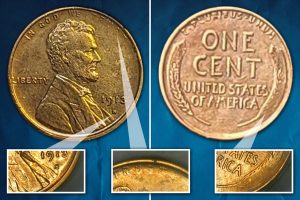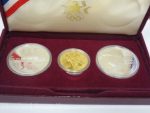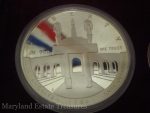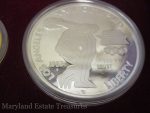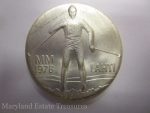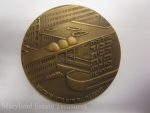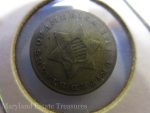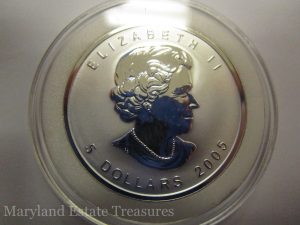Weekly World Numismatic News for January 23, 2022
The tradition continues on the Internet. Instead of Yellow Journalism, it is called clickbait. In the old days, editors used the headlines to sell newspapers so readers could see the advertising. Today, the headline writers want you to click the links to display advertising. It is the same principles even though the medium is different.
Some people do not like overly dramatic headlines and avoid those links. But there is one set of numismatic-related stories whose headlines you should not ignore.
The Sun is a UK-based tabloid newspaper owned by Ruppert Murdock. While the newspaper is known for yellow and tabloid journalism, the paper has well-written stories that are not sensational or salacious. With the power of the Internet, they brought The Sun to the U.S. using the same formula to get page impressions.
One of the story formulas The U.S. Sun uses is to lure readers is to watch eBay coin auctions as a basis to write about different coins. Once they find something interesting, the articles produced are well written, informative, and readable to the average collector.
A good example is the “PRETTY PENNY Rare Lincoln penny with wax filled die sells for $122 – see if you have one in your wallet“ is a headline that seems like clickbait. But if you read the article, it explains the issues with the filled die, looks at other research into the date and error and talks about what to look for when searching pocket change.
A journalist explained that these are formula stories. A formula story is written based on a publisher-defined style so that any writer can fill in the details and maintain standards. Writers who earn their pay by the story will create story formulas to publish as many stories as possible.
Given The U.S. Sun‘s ability to publish well-written stories about the coins they cover makes it an excellent educational read for all coin collectors regardless of knowledge level. Follow @coinsblog on Twitter for when I find these stories.
And now the news…
 → Read more at vervetimes.com
→ Read more at vervetimes.com
 → Read more at nymag.com
→ Read more at nymag.com
 → Read more at smithsonianmag.com
→ Read more at smithsonianmag.com
 → Read more at bbntimes.com
→ Read more at bbntimes.com
 → Read more at nytimes.com
→ Read more at nytimes.com
 → Read more at the-sun.com
→ Read more at the-sun.com
The Sad State of Television Numismatics
 Someone walked into my shop today with a box full of items he said that he wanted to consign to one of our auctions. He said that someone mentioned that I was knowledgeable about coins and wanted me to help liquidate his collection.
Someone walked into my shop today with a box full of items he said that he wanted to consign to one of our auctions. He said that someone mentioned that I was knowledgeable about coins and wanted me to help liquidate his collection.
I have to admit I was excited as he held a box that you would pack books in and not carry coins. We put the box down and opened the box and was instantly disappointed.
On the top was a complete set of the State Quarter packages from one of the television shopping networks. It was the type of stuff that was over-hyped by touting their “limited production” by the U.S. Mint.
Looking at a few of the packs, they contained two quarters for each state on a card. They appear that if they were graded, they would probably average MS-64 and be worth $5-7 each. If they grade higher, the coins could be worth more. It is not worth my time and money to have them graded. Further, in the liquidation auction business, I would doubt these would sell for more than $5 per card.
The look on his face when I told him was as if I kicked his dog. He then gave me the same familiar story: they cost so much; the guy on television said they were a limited run; they should be worth more; and many other tales as seen on TV.
Anyone who has worked in a coin shop or handled second-hand property has heard the stories. Someone with a slick marketing presence appears on television and spins the tale to sound better than it is. Sure, the State Quarter was a limited production, but the Mint produced hundreds of millions of each of those coins.
In addition to the State Quarters, he had coin sets produced by companies like the Franklin Mint and the National Collectors Mint. While I try not to promise what could happen in an auction and avoid asking how much they paid, he pulls out a Buffalo Nickel display still offered by one of these companies.
The display is a round wooden stand that can rotate on a base. Around the edges is a space for 25 Buffalo Nickels. The nickels on his stand looked to be in extra fine (XF) to almost uncirculated (AU) condition. On top of the stand is a pewter figure of a buffalo (bison) modeled after James Earle Fraser’s image.
It is a lovely display, but one that is not popular. A previous consignor had the display without the coins. We finally were able to sell it for $1.00 to someone who was going to take it apart and repurpose the wooden stand. Selling the nickels in today’s market should allow him to break even.
For the last 25 years, this gentleman bought these coins and medals at a premium above their value. The box had gold plated medals with micrograms of gold that are nearly worthless in the collector market. He did have some older sterling silver sets that he bought when silver was under $8 per ounce. He can make money on those items to make up with some of the losses.
After going through the box, I said that he would be lucky if I can get $500 for everything. That lead to the look as if I kicked his other dog.
He asked how these people get away with overcharging for their merchandise. Unfortunately, there are few laws regarding price gouging except in an emergency (like overcharging for gas during a crisis) or if done fraudulently. But these television hucksters are practiced and can afford the lawyers to tell them how far they can go before they cross the line.
There are no laws to prevent companies from calling themselves a mint. There are credible companies that use “Mint” as part of their business name (e.g., I have been a customer of Miller’s Mint from Long Island and highly recommend them). Others use the moniker to make their products sound more official than they are.
If you like the packaging and are willing to pay the premium for it, then enjoy your collectible. While the Buffalo Nickel stand is not my style, I can understand the appeal. But when it comes time to sell, the packaging has little to do with the numismatic value of the coins or medals.
Anything plated has less than a gram of the metal. There is so little plating that it is not worth the cost for someone to have melted.
Which reminds me, the “1933 Double Eagle Tribute Proof” plated with 14 micrograms of 24 karat gold is not worth the $19.95 they charge on television. Even at the current price of gold, the item contains less than 1-cent worth of gold ($0.00047).
It bothers me that I have to disappoint people like this. It is worse when I have to tell an older person, like the octogenarian gentlemen who was in my shop this week, that the collection he thought was an investment is not worth a lot.
I am not sure what can the industry can do to prevent this from happening. These are legitimate businesses whose marketing practices may be less than ethical but are legal.
Some might suggest that this is something the American Numismatic Association should try to deal with. The ANA may not be the right organization for this. Maybe a consortium that includes the Professional Numismatic Guild (PNG), the Industry Council for Tangible Assets (ICTA), and the ANA could work together to find a solution.
Until then, I am open to suggestions!
Weekly World Numismatic News for November 10, 2019
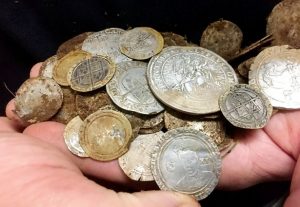
Hoard of coins found in Northern Ireland (Image of courtesy of Birmingham Live)
In Northern Ireland, two men looking for a friend’s lost wedding ring found a small hoard of 84 coins dating back to the 16th century. The oldest coin was dated 1512, which was during the reign of Henry VIII.
According to the story, the men who do this as a hobby, look at old maps and accounts of history to find areas that may be the sites of ancient villages or battles. Although I was surprised to read this, it makes sense, and it brings up an interesting point.
Finding artifacts buried in the ground, including coins, are a window into history. Researching where to search and understanding the history of a coin is like what archeologists do to unearth history.
I wonder if there is a way to welcome metal detectorists into the numismatic family?
And now the news…
 → Read more at finance101.com
→ Read more at finance101.com
 → Read more at telegraph.co.uk
→ Read more at telegraph.co.uk
 → Read more at theguardian.com
→ Read more at theguardian.com
 → Read more at thenewsguard.com
→ Read more at thenewsguard.com
 → Read more at barrons.com
→ Read more at barrons.com
 → Read more at birminghammail.co.uk
→ Read more at birminghammail.co.uk
October 2019 Numismatic Legislation Review
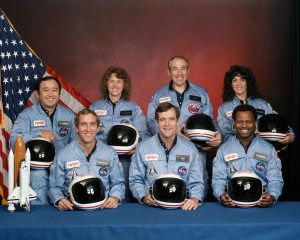
The STS-51L crewmembers are: in the back row from left to right: Mission Specialist, Ellison S. Onizuka, Teacher in Space Participant Sharon Christa McAuliffe, Payload Specialist, Greg Jarvis and Mission Specialist, Judy Resnik. In the front row from left to right: Pilot Mike Smith, Commander, Dick Scobee and Mission Specialist, Ron McNair. (Wikipedia)
For those who do not remember or were not born at the time, McAuliffe was selected as the first civilian teacher to fly into space as part of the Space Shuttle program. On January 28, 1986, she boarded the Space Shuttle Challenger along with Francis R. Scobee, Michael J. Smith, Ronald McNair, Ellison Onizuka, Judith Resnik, and Gregory Jarvis for mission STS-51-L. Challenger lifted off from Cape Canaveral at 11:39 AM.
It was an unusually cold morning, even for Florida. The cold and deterioration of the O-Rings that sealed the joints of the solid rocket boosters failed. The firey escape of fuel caused the external fuel tank to explode 73 seconds into the flight. Challenger disintegrated, taking the lives of the seven-member crew.
The surcharge of $10 per coin sold in 2021 will be paid to the For Inspiration and Recognition of Science and Technology (FIRST) robotics program “for the purpose of engaging and inspiring young people, through mentor-based programs, to become leaders in the fields of science, technology, engineering, and mathematics.”
S. 239: Christa McAuliffe Commemorative Coin Act of 2019
The House also passed the Women’s Suffrage Centennial Commemorative Coin Act (H.R. 2423) for 2020 and the National Law Enforcement Museum Commemorative Coin Act (H.R. 1865) for 2021. Both bills head to the Senate for their consideration.
H.R. 1865: National Law Enforcement Museum Commemorative Coin Act
H.R. 2423: Women’s Suffrage Centennial Commemorative Coin Act
Two additional commemorative coin bills were introduced in the House of Representatives. One is so new that the Government Printing Office has yet to release the official text.
H.R. 4681: National World War II Memorial Commemorative Coin Act
H.R. 4940: To require the Secretary of the Treasury to mint coins in commemoration of the 200th anniversary of the establishment of the Nation’s first statewide investigative law enforcement agency, the Ranger Division of the Texas Department of Public Safety.
Weekly World Numismatic Newsletter for November 3, 2019

A 1773 Virginia Halfpenny from the Colonial Williamsburg Collection (not my friend’s coin because I forgot to take pictures) (Image courtesy of Colonial Williamsburg)
He was in an area not far from Jamestown. The metal detector community in the area knows that it is possible to find small items dating back to colonial times. Most of the time, people find bullets and buttons from the Civil War era. They dream of finding something special.
On this day, my friend comes in excited. He finds what he thinks are colonial coins. If he is right, he could have hit the local jackpot. I asked to see the coins.
Upon pulling out the coins wrapped in cheesecloth, the first thing I noticed that the coins were round. But Scott, you say, coins are supposed to be round. I say that you are correct, but at a time when minting coins required striking dies with a hammer, the result is not perfectly round.
While laying the open cloth on my desk, the sound the coins made was suspicious. Anyone who has handled large copper coins knows the sound made by a dropped coin.
Picking up my trusty 16x loupe, I went to examine the coins when I picked them up and felt they were lighter than expected. A quick drop on the hard floor confirmed that they were aluminum.
My friend found souvenir coins from Colonial Williamsburg used as part of the experience of living in the 16th century. A tourist would pay for the coins then use them in the shops or to purchase dinner in the village. Quick online research suggested they were used in the 1980s.
We think some kids buried the coins while playing and forgot about them. Or someone was trying to fool a metal detectorist, like my friend.
Even though he had dreams of being in one of the stories I add to the weekly news digest, we had a good time hanging out and talking. After all, what is the point of collecting if you do not have fun!
And now the news…
 → Read more at siouxcityjournal.com
→ Read more at siouxcityjournal.com
 → Read more at fluxmagazine.com
→ Read more at fluxmagazine.com
 → Read more at dailymail.co.uk
→ Read more at dailymail.co.uk
 → Read more at dailymail.co.uk
→ Read more at dailymail.co.uk
 → Read more at coinspeaker.com
→ Read more at coinspeaker.com
My First Numismatic Auction
UPDATE: The auction is online and begins to close at 7:00 PM on Sunday, November 3, 2019!

Lot #1: Beautiful classic Liberty Head $2½ quarter eagle gold coin in a Capital Plastics holder.
A few weeks ago, someone walked into the shop and asked about consigning coins. The coins were something he inherited and did not know what to do with them. Then my consignor removed an 1878 Liberty $2½ quarter eagle gold coin in a Capital Plastics holder. It is a beautiful coin in hand. It looks uncirculated.
Although the 1984 U.S. Olympics Commemorative Set sare not popular, he handed two of the three-coin sets with the gold coin.
He continued to empty the bag, and I found Morgan and Peace dollars, Seated Liberty quarters, and a few other coins.
While unpacking another consignment, there was a 1 gram gold bar mixed in amongst the papers.Finally, someone brought in the few Israeli coins and medals his late father owned.
Put it all together, add a few of my surplus coins, and there are 54 total coins in my company’s current auction.
Here is a small sample of some of the coins in this auction:
We do ship!
If you want more than coins, check out the rest of the auction which includes sports autographs (like a Joe Montana autographed football), art (two prints from Yaacov Agam), a Black Forest Cukoo Clock (it works!), and so much more. Feel free to peruse the entire 284 lot auction.
But don’t forget the coins, including this 2005 Canadian Silver Maple Leaf silver bullion coin with a Rooster Privy Mark.
